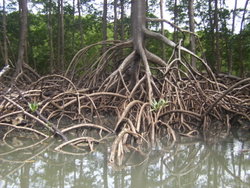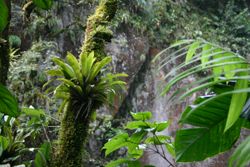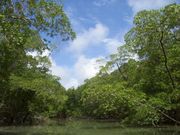Amazon Rainforest
2007 Schools Wikipedia Selection. Related subjects: Central & South American Geography
The Amazon Rainforest (in Portuguese, Floresta Amazônica or Amazônia — and in Spanish, Selva Amazónica) is a moist broadleaf forest in the Amazon Basin of South America. The area known as Amazonia or Amazon Basin encompasses 7 million km² (1.2 billion acres), though the forest itself occupies some 5.5 million km², located within eight nations: Brazil (with 60% of the rainforest), Colombia, Peru, Venezuela, Ecuador, Bolivia, Guyana and Suriname, as well as French Guiana. States or departments in four nations bear the name Amazonas for the Amazon. This forest represents over half of the planet's remaining rainforests. Amazonian rainforests comprise the largest and most species rich tract of tropical rainforest that exists.
Etymology
The name Amazon arises from a battle which Francisco de Orellana had with a tribe of Tapuyas where the women of the tribe fought alongside the men, as was the custom among the entire tribe. Orellana derived the name Amazonas from the ancient Amazons of Asia and Africa described by Herodotus and Diodorus.
Biodiversity

Wet tropical forests are the most species-rich biome, and tropical forests in the Americas are consistently more species rich than the wet forests in Africa and Asia. As the largest tract of tropical rainforest in the Americas, the Amazonian rainforests have unparalleled biodiversity.
The region is home to about 2.5 million insect species, tens of thousands of plants, and some 2000 birds and mammals. To date, at least 40,000 plant species, 3,000 fish, 1,294 birds, 427 mammals, 427 amphibians, and 378 reptiles have been scientifically classified in the region . Scientists have described between 96,660 and 128,843 invertebrate species in Brazil alone .
The diversity of plant species is the highest on earth with some experts estimating that one square kilometre may contain over 75,000 types of trees and 150,000 species of higher plants . One square kilometre of Amazon rainforest can contain about 90,790 tons of living plants. This constitutes the largest collection of living plants and animal species in the world. One in five of all the birds in the world live in the rainforests of the Amazon . To date, an estimated 438,000 species of plants of economic and social interest have been registered in the region with many more remaining to be discovered or catalogued .
Deforestation
Deforestation is the conversion of forested areas to non-forested areas. More than one fifth of the Amazon Rainforest has already been destroyed , and the forest which remains is threatened. In a span of just ten years between 1991 and 2000, the total area of forest lost in the Amazon rose from 415,000 to 587,000 km² - an area twice the size of Portugal, with most of the lost forest becoming pasture for cattle . In 1996, the Amazon was reported to have shown a 34% increase in deforestation since 1992. The mean annual deforestation rate from 2000 to 2005 (22,392 km² per year) was 18% higher than in the previous five years (19,018 km² per year).
In Brazil the Instituto Nacional de Pesquisas Espaciais - (National Institute of Space Research, or INPE) produces deforestation figures annually. Their deforestation estimates are derived from 100 to 220 images taken during the dry season in the Amazon by the Landsat satellite, and only consider the loss of the Amazon rainforest biome – not the loss of natural fields or savannah within the rainforest. According to INPE, the original Amazon rainforest biome in Brazil of 4,100,000 km² was reduced to 3,403,000 km² by 2005 – representing a loss of 17.1% .
A new report by a Brazilian congressional committee says the Amazon is vanishing at a rate of 52,000 square kilometers per year (20,000 miles² per year), over three times the rate for which the last official figures were reported in 1994, at this rate the Amazon rainforest will be gone by 2050.
Carbon dynamics
Not only are environmentalists concerned about the loss of biodiversity which will result from destruction of the forest, they are also concerned about the release of the carbon contained within the vegetation, which could accelerate global warming.
Amazonian evergreen forests account for about 10% of the world's terrestrial primary productivity and 10% of the carbon stores in ecosystems — of the order of 1.1 x 1011 metric tonnes of carbon . Amazonian forests are estimated to have accumulated 0.62 ± 0.37 tonnes of carbon per hectare per year between 1975 and 1996 . Fires related to Amazonian deforestation have made Brazil one of the top greenhouse gas producers. Brazil produces about 300 million metric tonnes of carbon dioxide a year; 200 million of these are come from logging and burning in the Amazon.
Conservation
Some environmentalists commonly state the fact that there is not only a biological incentive to protecting the rainforest, but also an economic one. One hectare in the Peruvian Amazon has been calculated to have a value of $6820 if intact forest is sustainably harvested for fruits, latex, and timber; $1000 if clear-cut for commercial timber (not sustainably harvested); or $148 if used as cattle pasture. However, the assumptions of this study have been widely challenged.
The Força Aérea Brasileira has been using Embraer R-99 surveillance aircraft, as part of the SIVAM program, to monitor the forest. At a conference in July 2004, scientists warned that the rainforest will no longer be able to absorb the millions of tons of greenhouse gases annually, as it usually does, because of the increased pace of rainforest destruction. 9,169 square miles of rain forest were cut down in 2003 alone.
In Brazil alone, more than 90 indigenous groups have been destroyed by colonists since the 1900s, and with them have gone centuries of accumulated knowledge of the medicinal value of rainforest species. As indigenous territories continue to be destroyed by deforestation, and ecocide, such as in the Peruvian Amazon indigenous peoples' rainforest communities continue to disappear, while others, like the Urarina continue to struggle to fight for their cultural survival and the fate of their forested territories. Meanwhile, the relationship between nonhuman primates in the subsistence and symbolism of indigenous lowland South American peoples has gained increased attention, as has ethno-biology and community-based conservation efforts.
Response to climate change
There is evidence that there have been significant changes in Amazon rainforest vegetation over the last 21,000 years through the last glaciation (LGM) and subsequent deglaciation. Analyses of sediment deposits from Amazon basin paleolakes and from the Amazon Fan indicate that rainfall in the basin during the LGM was lower than for the present, and this was almost certainly associated with reduced moist tropical vegetation cover in the basin. There is debate, however, over how extensive this reduction was. Some scientists argue that the rainforest was reduced to small, isolated refugia separated by open forest and grassland; other scientists argue that the rainforest remained largely intact but extending less far to the North, South and East than is seen today . This debate has proved difficult to resolve because the practical limitations of working in the rainforest mean that data sampling is biased away from the centre of the Amazon basin, and both explanations are reasonably well supported by the available data.
One computer model of future climate change due to greenhouse gas emissions shows that the Amazon rainforest could become unsustainable under conditions of severely reduced rainfall and increased temperatures, leading to an almost complete loss of rainforest cover in the basin by 2100. However, simulations of Amazon basin climate change across many different models are not consistent in their estimation of any rainfall response, ranging from weak increases to strong decreases . The result indicates that the rainforest could be threatened though the 21st century by climate change in addition to deforestation.
Impact of Amazon drought
In 2005, parts of the Amazon basin experienced the worst drought in 100 years, and there are indications that 2006 could be a second successive year of drought. A 23 July 2006 article in the UK newspaper The Independent reported Woods Hole Research Centre results showing that the forest in its present form could survive only three years of drought. Scientists at the Brazilian National Institute of Amazonian Research argue in the article that this drought response, coupled with the effects of deforestation on regional climate, are pushing the rainforest towards a " tipping point" where it would irreversibly start to die. It concludes that the forest is on the brink of being turned into savanna or desert, with catastrophic consequences for the world's climate. According to the WWF, the combination of climate change and deforestation increases the drying effect of dead trees that fuels forests fires.
Video
- Documentary: About Tristes Tropiques
- Documentary: War of Pacification in Amazonia




